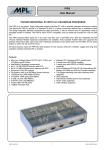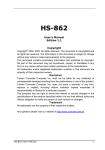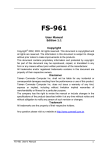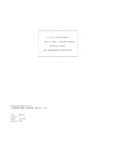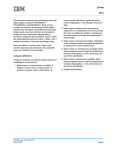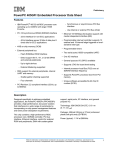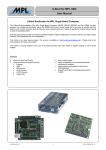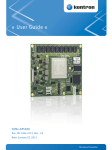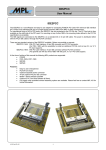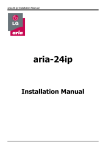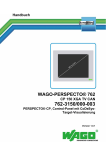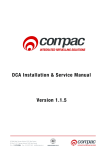Download MIP405 USERS MANUAL - MPI Distribution AG
Transcript
MIP405 USERS MANUAL High-Tech • Made in Switzerland MPL Industrial PC with IBM PowerPC™ Processor The MIP405 is a highly integrated industrial single board computer in PC/104 form factor. Build around the PPC405 IBM PowerPC™ Processor it is well suited for applications requiring small size, high performance and Low Power. The MIP405 can be used in a standard operating environment without the necessity of a fan. All major components required to build a industrial PC system are implemented on a single PC/104 sized board. It features two E-IDE, one 10/100Base TX Ethernet, two USB Ports, four serial ports, speaker output, and a real time clock. The 16-bit PC/104 and the PC/104+ (PCI) interface offers easy and flexible expansion capabilities. Integration of the MIP405 into a system is facilitated by the fact of offering standard connectors E-IDE (44 pin header) and LAN (2mm 12pin header or RJ45). The serial interfaces can be accessed through 2mm 10pin headers. Particular precaution has been taken to the EMC so that an entire system can fulfill the CE and FCC requirements. The SDRAM is soldered on board and is available with ECC. All these features make the MIP405 to the ideal solution for any low-cost embedded control application where a flexible industrial PC is needed. Features • • • • • • • • • Low Power IBM PPC405 Processor Processor clock 266 / 400 MHz Up to 128MByte ECC SDRAM on board. Integrated 10/100 Mbit/s Ethernet Controller PC/104 and PC/104 Plus interface © 2001 by MPL AG 1 2 USB Ports Two EIDE HDD ports Four RS232 ports Low power consumption MEH-10085-001 Rev. G MIP405 User Manual High-Tech • Made in Switzerland TABLE OF CONTENTS 1. 1.1 1.2 1.3 1.4 1.5 2. INTRODUCTION ........................................................................................................................................................ 4 About this manual ................................................................................................................................................. 4 MIP405 Variants.................................................................................................................................................... 4 Safety precautions and handling ........................................................................................................................... 4 Electrostatic discharge (ESD) protection............................................................................................................... 4 Equipment safety .................................................................................................................................................. 4 GENERAL INFORMATION AND SPECIFICATIONS ................................................................................................. 5 2.1 Specifications ........................................................................................................................................................ 5 2.1.1 Electrical.......................................................................................................................................................... 5 2.1.2 Physical / Power .............................................................................................................................................. 7 2.1.3 Environment .................................................................................................................................................... 7 2.2 Dimensions ........................................................................................................................................................... 8 3. PREPARATION FOR USE ......................................................................................................................................... 9 3.1 Parts location ........................................................................................................................................................ 9 3.1.1 Top view .......................................................................................................................................................... 9 3.1.2 Bottom view................................................................................................................................................... 10 3.2 Switch settings .................................................................................................................................................... 11 3.2.1 DIP switch S1 – Software Configuration switch ............................................................................................. 11 3.2.2 DIP switch S2 – Hardware Configuration Switch ........................................................................................... 11 3.3 Indicators ............................................................................................................................................................ 11 3.4 Connectors.......................................................................................................................................................... 12 3.4.1 J1 – Serial port SER0 connector ................................................................................................................... 12 3.4.2 J2 – Serial port COMA connector .................................................................................................................. 12 3.4.3 J3 – Debug/JTAG connector ......................................................................................................................... 12 3.4.4 J4 – Serial port SER1 connector ................................................................................................................... 13 3.4.5 J5 – Serial port COMB connector .................................................................................................................. 13 3.4.6 J6 – Speaker / SMBus connector .................................................................................................................. 13 3.4.6.1 Connecting an external Reset Switch 14 3.4.7 J8/J11 - PC104 interface pin numbers .......................................................................................................... 15 3.4.8 J10 - PC104+ Interface pin numbers ............................................................................................................. 16 3.4.9 J12 - 10/100BASETX RJ45 Connector (only for Variants with Ethernet on RJ45) ........................................ 17 3.4.10 J13 – 10/100BASETX Header Connector (only for Variants with Ethernet on Header)............................. 17 3.4.11 J14 - USB Connector ................................................................................................................................ 17 3.4.12 E-IDE connectors ...................................................................................................................................... 18 3.4.12.1 J23 - Standard E-IDE connector 18 3.5 U4 - Multi purpose socket ................................................................................................................................... 19 3.5.1 Mounting Memory Modules ........................................................................................................................... 19 3.5.2 Switch settings for the Multi Purpose Socket................................................................................................. 19 3.5.3 Required module properties .......................................................................................................................... 19 3.5.4 Device types Examples for the Multi Purpose Socket: .................................................................................. 20 3.5.5 External bootloader ....................................................................................................................................... 20 4. OPERATION............................................................................................................................................................. 21 4.1 Block diagram ..................................................................................................................................................... 21 4.2 Memory Map ....................................................................................................................................................... 22 4.2.1 PPC405 System Mapping ............................................................................................................................. 22 4.3 MIP405 Memory Mapping ................................................................................................................................... 23 4.4 Local bus to PCI Mapping ................................................................................................................................... 23 4.5 DUART Operation ............................................................................................................................................... 24 4.5.1 Baudrate Clock .............................................................................................................................................. 24 4.6 Interrupts............................................................................................................................................................. 26 4.6.1 CPU Interrupts............................................................................................................................................... 26 4.6.2 ISA Interrupts ................................................................................................................................................ 26 4.7 Extension registers.............................................................................................................................................. 27 4.7.1 PLD Partnumber Register ............................................................................................................................. 27 4.7.2 PLD Version Register .................................................................................................................................... 27 4.7.3 Board Revision and Config Register.............................................................................................................. 27 4.7.4 IRQ Register.................................................................................................................................................. 28 4.7.5 Communication Mode Register ..................................................................................................................... 28 © 2003 by MPL AG 2 MEH-10085-001 Rev. G MIP405 User Manual High-Tech • Made in Switzerland 5. MODULE STACK ..................................................................................................................................................... 29 6. DEBUG CABLE FOR MIP405 .................................................................................................................................. 29 7. SUPPORT INFORMATION ...................................................................................................................................... 30 7.1 7.2 MPL AG .............................................................................................................................................................. 30 Production serial and revision number ................................................................................................................ 30 © 2003 by MPL AG 3 MEH-10085-001 Rev. G MIP405 User Manual High-Tech • Made in Switzerland 1. Introduction 1.1 About this manual This manual assists the installation and initialization procedure by providing all hardware related information necessary to handle and configure the MIP405. For all bootloader related information please refer to the “U-Boot User Manual for MPL SBC (MEH-10082-002)” supplied by MPL AG or your local MIP405 supplier. The U-Boot User Manual for MPL SBC” is also available on the internet under http://www.mpl.ch in PDF format. The manual is written for technical personnel responsible for integrating the MIP405 into their system. 1.2 MIP405 Variants Since the MIP405 is available in various population options, the information in this Manual about Memory size, Processor speed etc. may vary with your MIP405. The table below lists the actual (as of July 2003) variants, for an actual table please consult http://www.mpl.ch. Variants CPU SDRAM Flash Ethernet Temperature Range MIP405-1 PPC405GP/266MHz 128MByte ECC 4MByte RJ45 0°C ... 60°C MIP405-2 PPC405GP/266MHz 64MByte ECC 4MByte Header -40°C ... 85°C MIP405-3 PPC405GPr/400MHz 128MByte ECC 8MByte Header 0°C ... 60°C MIP405-4 PPC405GP/266MHz 128MByte ECC 4MByte Header 0°C ... 60°C Table 1.2.1 MIP405 Variants Note: Not all of the variants may be available. Please consult for http://www.mpl.ch available variants. 1.3 Safety precautions and handling For personal safety and safe operation of the MIP405, follow all safety procedures described here and in other sections of the manual. • • • Power must be removed from the system before installing (or removing) the MIP405 to prevent the possibility of personal injury (electrical shock) and/or damage to the product. Handle the product carefully, i.e., dropping or mishandling the MIP405 can cause damage to assemblies and components. Do not expose the equipment to moisture. WARNING There are no user-serviceable components on the MIP405 1.4 Electrostatic discharge (ESD) protection Various electrical components within the product are sensitive to static and electrostatic discharge (ESD). Even a nonsensible static discharge can be sufficient to destroy or degrade a component's operation! 1.5 Equipment safety Great care is taken by MPL that all its products are thoroughly and rigorously tested before leaving the factory to ensure that they are fully operational and conform to specification. However, no matter how reliable a product, there is always the remote possibility that a defect may occur. The occurrence of a defect on this device may, under certain conditions, cause a defect to occur in adjoining and/or connected equipment. It is the user’s responsibility to ensure that adequate protection for such equipment is incorporated when installing this device. MPL accepts no responsibility whatsoever for such kind of defects, however caused. © 2003 by MPL AG 4 MEH-10085-001 Rev. G MIP405 User Manual High-Tech • Made in Switzerland 2. General information and specifications This chapter provides a general overview over the MIP405 and its features. It outlines the electrical and physical specifications of the product, its power requirements and a list of related publications. 2.1 Specifications 2.1.1 Electrical Processor: • IBM PPC405GP/PPC405GPr PowerPC™ 32Bit RISC Processor • Separate, configurable, two-way set-associative instruction (16 kByte) and data (8/16 kByte) cache units • Clock frequency 266/400 MHz • Very low power consumption Bootloader ROM: • Up to 4/8MB Flash EEPROM • 512kB U-Boot (open source) boot loader • Easy boot loader update Memory: • up to 128MByte SDRAM on board • ECC Support Multi Purpose Socket: • Supports different SRAM/FLASH/EPROM, 32 Pin DIL memory components • Memory sizes up to 2MByte (EPROM) RTC: • Backed with onboard battery • Year 2000 compliant PC/104 /Plus Interface: • ISA bridge Intel 82371EB (Southbridge) • 16 Bit PC/104 interface • 32 Bit PC/104 Plus Interface (PCI Host) © 2003 by MPL AG 5 MEH-10085-001 Rev. G MIP405 User Manual High-Tech • Made in Switzerland USB: • 2 USB 1.0 ports for serial transfers at 12 or 1.5 Mbit/s • ESD protected Serial ports: • Four serial Ports 16C550 compatible • Two serial ports with RS232 signaling (SER0 and SER1). • Two serial port with TTL signaling (COMA and COMB) • Standard transfer rates up to 460 kBaud • Optional transfer rates up to 1.15 MBaud • 3 ports with full modem handshake (SER0, COMA and COMB) • Available on four 10pin 2mm headers E-IDE ports: • 2 separate channels for up to 4 drives • available on 44 pin header, 2 mm pitch, for 2,5” Notebook hard disk. • PIO Mode 4 and Bus Master IDE, transfers up to 14 Mbytes/s • Ultra DMA/33 mode, synchronous DMA mode transfers up to 33 Mbytes/s • Activity indicator on board Ethernet: • PPC405GP/PPC405GPr integrated 10/100 MBit/s Ethernet Controller • IEEE802.3 10BASE-T and 100BASE-TX compatible • IEEE 802.3u Autonegotiation Support • IEEE 802.3x 100BASE-TX Flow Control support • Activity indicators for link detection/network traffic and 100 Mbit/s operation on board • ESD protected Speaker: • Available on a 10-pin 2mm header Indicators: • Power LED (green) • Reset / Power Fail LED (red) • Error LED (red) • HDD activity LED (green) • LAN LED (green) • 1 user programmable LED (green) © 2003 by MPL AG 6 MEH-10085-001 Rev. G MIP405 User Manual High-Tech • Made in Switzerland 2.1.2 Physical / Power Form factor: PC/104, with connectors in defined I/O connectors overhang regions Length: 95.9 mm (3.775 inches) Width: 115.6 mm (4.550 inches) Height: 14.0 mm (0.550 inch) (excluding PC/104 bus connectors) Weight: Typical 110g (fully equipped, without memory module) Power supply: Over PC/104 bus interface or through separate 3-pin Mini-Combicon power connector. Input Power requirement: +5V: +5VDC ± 5% Power consumption: PPC405GP @266MHz: Typical. 800mA@5V (with Ethernet, USB and 128MB SDRAM) PPC405GPr @400MHz: Typical. 600mA@5V (with Ethernet, USB and 128MB SDRAM) 2.1.3 Environment Temperature range: 0°C to +60°C (+32°F to +140°F) @ 266/400 MHz CPU speed without heat sink extended temperature range available Relative humidity: 10% ... 90% non condensing © 2003 by MPL AG 7 MEH-10085-001 Rev. G MIP405 User Manual High-Tech • Made in Switzerland 2.2 Dimensions 82.5 16.51 8.9 Units: mm 95.9 90.8 90.8 87.6 10.16 8.3 5.1 5.1 1 6.35 12.7 9.9 (Power supply plug is only used if not powered via the PC104 Connector) 85.1 90.2 12.7 115.6 14.0 3.2 max 1.6 Figure 2.2.1 Dimensions MIP405 Drawing not to scale. Since the PC104 Plus of the MIP405 is implemented as PCI Host, the MIP405 is not a stack-through board. Please see Chapter 5 Module Stack for further information. © 2003 by MPL AG 8 MEH-10085-001 Rev. G MIP405 User Manual High-Tech • Made in Switzerland 3. Preparation for use 3.1 Parts location 3.1.1 Top view 12 11 J13 100/10MBit Network Connector 2 1 J10 PC104+ (PCI) Connector J1 SER0 Connector 1 2 D4 D5 D6 D7 D3 D8 1 2 30 1 D C B A J4 SER1 Connector J2 COMA Connector 9 10 1 2 9 10 1 2 44 43 44 43 J12 100/10MBit Network Connector J5 COMB Connector J3 Debug/JTAG Connector J6 Speaker/SMBus Connector 9 10 9 10 1 2 1 2 J16 Secondary IDE Port 9 10 J15 Primary IDE Port 11 12 U4 Multi Purpose Socket 2 1 2 1 10 9 J14 USB Connector 30 B A 1 C D 0 1 2 1 19 J8/J11 PC104 Connector 3 J9 Power Connector Figure 3.1.1 Parts location Top view © 2003 by MPL AG 9 MEH-10085-001 Rev. G MIP405 User Manual High-Tech • Made in Switzerland 3.1.2 Bottom view 1 2 3 4 5 6 7 8 O N S1 Switch S2 Switch 1 2 3 4 5 6 7 8 O N Figure 3.1.2 Parts location Bottom view MIP405 © 2003 by MPL AG 10 MEH-10085-001 Rev. G MIP405 User Manual High-Tech • Made in Switzerland 3.2 Switch settings Default switch settings are bold. 3.2.1 DIP switch S1 – Software Configuration switch The Software configuration switch is readable by reading the register EXT_REG. Switch On Off Console is serial line 1 S1-1 Console assignment from Environment not yet defined S1-2 not yet defined not yet defined S1-3 not yet defined not yet defined S1-4 not yet defined not yet defined S1-5 not yet defined not yet defined S1-6 not yet defined not yet defined S1-7 not yet defined not yet defined S1-8 not yet defined S1 O N 1 2 3 4 5 6 7 8 Table 3.2.1 S1: Software Configuration Switch Notes: • A switch in ON Position will be read back as High 3.2.2 DIP switch S2 – Hardware Configuration Switch Switch S2-1 S2-2 S2-3 S2-4 S2-5 S2-6 S2-7 S2-8 On Battery backup enabled Boot Flash VPP enabled Boot Flash Write protected EEPROM Write enabled Boot from MPS MPS CFG0 (Off) MPS CFG1 (Off) MPS CFG2 (On) Off Battery backup disabled Boot Flash VPP disabled Boot Flash Write enabled EEPROM Write protected Boot from Boot Flash S2 1 2 3 4 5 6 7 8 O N Table 3.2.2 S2: Hardware Configuration Switch Notes: • • Boot Flash VPP and WP works only with some Boot flash Devices. Switch S2-6 to S2-8 are used to configure the device used on the MPS. Refer to 3.5 U4 - Multi purpose socket for details. 3.3 Indicators Ref Color Description D8 green Power LEDs Lit when 5V is Ok D8 Power D7 red Reset Lit when PPC405 is in Reset D7 Reset D6 Error D6 red Error Lit when PPC405 has detected an Error (Sys_Error) D5 HDD D4 LAN D3 User D5 green HDD Lit when IDE activity D4 green LAN Lit when Network activity D3 green USER Lit if bit ULED in Register COM_Mode is set Table 3.3.1 Indicators © 2003 by MPL AG 11 MEH-10085-001 Rev. G MIP405 User Manual High-Tech • Made in Switzerland 3.4 Connectors 2 1 3.4.1 J1 – Serial port SER0 connector The serial port SER0 is implemented as RS232 full Modem Handshake interface. For reference the pin numbering on a DB9 male connector has been included. Number Signal Description DB9 male Pinout 1 DCD0 Carrier detect 1 2 DSR0 Data set ready 6 3 RXD0 Receive data 2 4 RTS0 Request to send 7 5 TXD0 Transmit data 3 6 CTS0 Clear to send 8 7 DTR0 Data terminal ready 4 8 RI0 Ring indicator 9 9 GND Ground 5 10 EARTH Earth Shield 10 9 Table 3.4.1 J1 Serial port SER0 connector 2 1 3.4.2 J2 – Serial port COMA connector The serial port COMA is implemented as a full Modem Handshake interface with TTL level signaling. Number Signal Description Pinout 1 DCDA Carrier detect 2 DSRA Data set ready 3 RXDA Receive data 4 RTSA Request to send 5 TXDA Transmit data 6 CTSA Clear to send 7 DTRA Data terminal ready 8 RIA Ring indicator 9 GND Ground 10 VCC5 5V power supply 10 9 Table 3.4.2 J2 Serial port COMA connector Pinout 2 1 12 11 3.4.3 J3 – Debug/JTAG connector The Debug JTAG Connector uses a non standard Pinout on a 12Pin 2mm Header. Number Signal Description 1 VCC5 5V power supply 2 GND Ground 3 CPU TDO CPU JTAG Data Out 4 CPU TDI CPU JTAG Data In 5 CPU_TRST# CPU JTAG Reset 6 CPU_TCK CPU JTAG Clock 7 CPU TMS CPU JTAG Mode Select 8 CPU HALT# CPU Halt 9 PLD TDI PLD JTAG Data In 10 PLD TDO PLD JTAG Data Out 11 PLD TMS PLD JTAG Mode Select 12 PLD TCK PLD JTAG Clock Table 3.4.3 J3 Debug/JTAG connector © 2003 by MPL AG 12 MEH-10085-001 Rev. G MIP405 User Manual High-Tech • Made in Switzerland 2 1 3.4.4 J4 – Serial port SER1 connector The serial port SER1 is implemented as RS232 Interface. Since the PPC405 supports only CTS/RTS or DSR/DTR hardware handshake, others hardware handshake signals are not available. To switch between the CTS/RTS to DSR/DTR handshake, set the bit SER1_ALT in the COM_MODE register, clear the Bit DCS, and set the bit RDS in the Register CHCR0 of the PPC405. For reference the pin numbering on a DB9 male connector has been included. Number Signal Description DB9 male Pinout 1 NC Not connect 1 2 DSR1 Data set ready 6 3 RXD1 Receive data 2 4 RTS1 Request to send 7 5 TXD1 Transmit data 3 6 CTS1 Clear to send 8 7 DTR1 Data terminal ready 4 8 NC Not connect 9 9 GND Ground 5 10 EARTH Earth Shield 10 9 Table 3.4.4 J4 Serial port SER1 connector 2 1 3.4.5 J5 – Serial port COMB connector The serial port COMB is implemented as a full Modem Handshake interface with TTL level signaling. Number Signal Description Pinout 1 DCDB Carrier detect 2 DSRB Data set ready 3 RXDB Receive data 4 RTSB Request to send 5 TXDB Transmit data 6 CTSB Clear to send 7 DTRB Data terminal ready 8 RIB Ring indicator 9 GND Ground 10 VCC5 5V power supply 10 9 Table 3.4.5 J5 Serial port COMB connector 2 1 3.4.6 J6 – Speaker / SMBus connector For system expansions the System Management Bus (SMBus), some General Purpose In/Output Signals along with the speaker signals are available on the connector J6. Number Signal Description Pinout 1 VCC3 3.3V Power supply 2 SMBCLK SMBus clock 3 SMBDATA SMBus data 4 GPI11 General Purpose Input 11 5 GPI13 General Purpose Input 13 6 GND Ground 7 GPO27 General Purpose Output 27 8 GPO28 General Purpose Output 28 9 VCC5 5V power supply (for the Speaker) 10 SPKR Speaker 10 9 Table 3.4.6 J6 Speaker/SMBus connector Notes: © 2003 by MPL AG All the Signals on the J6 are connected to the SouthBridge PIIX4E 82371EB. So the General Purpose Inputs/Outputs are the GPIO of the PIIX4E and not of the CPU. The names of the GPIOs correspond with the names of the ones of the PIIX4E. The Speaker Signal is the buffered Output (open-drain) to the SPRK Signal of the PIIX4E, which is driven by the Counter 2 of the PIIX4E. For further information please refer to the SouthBridge Manual. 13 MEH-10085-001 Rev. G MIP405 User Manual High-Tech • Made in Switzerland J9 - Power Connector This connector is needed if no power via PC104 bus is provided. No other inputs than this and the power inputs on PC104 bus must be used to power the board. 3-pin power connector Phoenix Contact AG type MC1,5/3-G-3.81 pinout: Pin number Signal 1 VIN 2 GND 3 SRESET# Description Pinout Input voltage (+5 VDC) Ground System Reset Input (active low) 1 2 3 Table 3.4.7 J9 Power connector Counterpart is the Phoenix Contact AG connector type MC1,5/3-ST-3.81 (5-10A). WARNING Be aware of the input voltage polarization ! Wrong polarization of the input voltage can cause serious damage to the MIP405 and attached peripherals! 3.4.6.1 Connecting an external Reset Switch On the SRESET# input on the External Power Connector exists the possibility to mount an external Reset Switch for system reset, see Figure 3-3. The SRESET# input is active low and can be connected directly to an open drain output (internal 10kΩ pull up resistor to 3.3V). 1 2 3 Reset Button + VIN Figure 3-3 Mounting an External Reset Switch WARNING Do not apply other voltages than Vin- or tristate to the SRESET# input! Exceeding these limits can cause serious damage to the MIP405! © 2003 by MPL AG 14 MEH-10085-001 Rev. G MIP405 User Manual High-Tech • Made in Switzerland 3.4.7 J8/J11 - PC104 interface pin numbers Number 0 1 2 3 4 5 6 7 8 9 10 11 12 13 14 15 16 17 18 19 20 21 22 23 24 25 26 27 28 29 30 31 32 Row A -/IOCHCK SD7 SD6 SD5 SD4 SD3 SD2 SD1 SD0 IOCHRDY AEN SA19 SA18 SA17 SA16 SA15 SA14 SA13 SA12 SA11 SA10 SA9 SA8 SA7 SA6 SA5 SA4 SA3 SA2 SA1 SA0 GND Row B -GND RSTDRV +5V IRQ9 (-5V) 1 DRQ2 (-12V) 1 /ENDXFR (+12V) 1 NC /SMEMW /SMEMR /IOW /IOR /DACK3 DRQ3 /DACK1 DRQ1 /REFRESH SYSCLK IRQ7 IRQ6 IRQ5 IRQ4 IRQ3 /DACK2 TC BALE +5V OSC GND GND Row C GND /SBHE LA23 LA22 LA21 LA20 LA19 LA18 LA17 /MEMR /MEMW SD8 SD9 SD10 SD11 SD12 SD13 SD14 SD15 NC -------------- Row D GND /MEMCS16 /IOCS16 IRQ10 IRQ11 IRQ12 IRQ15 IRQ14 /DACK0 DRQ0 /DACK5 DRQ5 /DACK6 DRQ6 /DACK7 DRQ7 +5V (/MASTER) 1 GND GND -------------- Pinout AB 1 DC 0 19 32 Table 3.4.8 PC/104 connector Notes: 1 © 2003 by MPL AG Signal not available. (-5V, +12V and -12V are not connected and /MASTER is pulled-down to GND) 15 MEH-10085-001 Rev. G MIP405 User Manual High-Tech • Made in Switzerland 3.4.8 J10 - PC104+ Interface pin numbers Number 1 2 3 4 5 6 7 8 9 10 11 12 13 14 15 16 17 18 19 20 21 22 23 24 25 26 27 28 29 30 Row A GND +5V AD5 C/BE0 GND AD11 AD14 (+3.3V)2 SERR GND STOP (+3.3V) 2 FRAME GND AD18 AD21 (+3.3V) 2 IDSEL0 AD24 GND AD29 +5V REQ0 GND GNT1 +5V CLK2 GND (+12V) 1 (-12V) 1 Row B NC AD2 GND AD7 AD9 +5V AD13 C/BE1 GND PERR (+3.3V) 2 TRDY GND AD16 (+3.3V) 2 AD20 AD23 GND C/BE3 AD26 +5V AD30 GND REQ2 +5V CLK0 +5V INTD INTA NC Row C +5V AD1 AD4 GND AD8 AD10 GND AD15 (SBO) 1 (+3.3V) 2 (LOCK) 1 GND IRDY (+3.3V) 2 AD17 GND AD22 IDSEL1 +5V AD25 AD28 GND REQ1 +5V GNT2 GND CLK3 +5V INTB NC Row D AD0 +5V AD3 AD6 GND (M66EN) 1 AD12 (+3.3V) 2 PAR (SDONE) 1 GND DEVSEL (+3.3V) 2 C/BE2 GND AD19 (+3.3V) 2 IDSEL2 IDSEL3 GND AD27 AD31 +5V GNT0 GND CLK1 GND RST INTC GND Pinout ABCD 1 30 Table 3.4.9 J10 PC/104 Plus connector Notes: 1 2 © 2003 by MPL AG Signal not available. (SBO, SDONE and LOCK are pull-up to 5V, M66EN is connected to GND and +12V and -12V are not connected). 3.3V pins are connected to a plane, but due to Power supply constrains, they are not connected to the 3.3V of the Power Supply. 16 MEH-10085-001 Rev. G MIP405 User Manual High-Tech • Made in Switzerland 3.4.9 J12 - 10/100BASETX RJ45 Connector (only for Variants with Ethernet on RJ45) Standard RJ45 Connector for a 100 Ohm Cable Pin number Signal Description Pinout 1 TX+ Transmit data + 2 TXTransmit data 1 8 3 RX+ Receive data + 4 NC Not connected 5 NC Not connected 6 RXReceive data 7 NC Not connected 8 NC Not connected Table 3.4.10 10/100Base TX connector 2 1 12 11 3.4.10 J13 – 10/100BASETX Header Connector (only for Variants with Ethernet on Header) 12Pin 2mm Header. Number Signal Description Pinout 1 TX+ Transmit Data + 2 TXTransmit Data 3 RX+ Receive Data + 4 TERM1 Termination 1 5 6 RXReceive Data 7 TERM2 Termination 2 8 9 NC 10 NC 11 EARTH Shield 12 EARTH Shield Table 3.4.11 J13 10/100Base TX Header 2 1 10 9 3.4.11 J14 - USB Connector The USB connector is a 10 pin 2mm pitch header. It has the signals for two USB ports on it. Pin number Signal Description Pinout 1 VCC Cable Power +5VDC Port1 2 VCC Cable Power +5VDC Port2 3 Data1Balanced Data Line– Port1 4 Data2Balanced Data Line– Port2 5 Data1+ Balanced Data Line+ Port1 6 Data2+ Balanced Data Line+ Port2 7 GND Cable Ground Port1 8 GND Cable Ground Port2 9 NC Not connected 10 NC Not connected Table 3.4.12 J14 USB connector © 2003 by MPL AG 17 MEH-10085-001 Rev. G MIP405 User Manual High-Tech • Made in Switzerland 3.4.12 E-IDE connectors There are two 44 pin header / 2 mm pitch E-IDE connectors on the MIP405. Physically each connector works as an independent IDE channel. J15 is connected to the primary and J16 is connected to the secondary port. 3.4.12.1 J23 - Standard E-IDE connector Pin 1 3 5 7 9 11 13 15 17 19 21 23 25 27 29 31 33 35 37 39 41 43 Signal /RESET D7 D6 D5 D4 D3 D2 D1 D0 GND DRQ IOW IOR IORDY DACK IRQ A1 A0 CS0 ACTLED VCC GND Description Reset Data bit 7 Data bit 6 Data bit 5 Data bit 4 Data bit 3 Data bit 2 Data bit 1 Data bit 0 Ground DMA request I/O write strobe I/O read strobe I/O ready DMA acknowledge Interrupt request Address 1 Address 0 Chipselect 0 Activity LED +5V Ground Pin 2 4 6 8 10 12 14 16 18 20 22 24 26 28 30 32 34 36 38 40 42 44 Signal GND D8 D9 D10 D11 D12 D13 D14 D15 KEY GND GND GND HDBALE GND IOCS16 NC A2 CS1 GND VCC GND Description Ground Data bit 8 Data bit 9 Data bit 10 Data bit 11 Data bit 12 Data bit 13 Data bit 14 Data bit 15 Key / not connected Ground Ground Ground Spindle sync / cable select Ground I/O chipselect16 Not connected Address 2 Chipselect 1 Ground +5V Ground Table 3.4.13 EIDE connectors © 2003 by MPL AG 18 MEH-10085-001 Rev. G MIP405 User Manual High-Tech • Made in Switzerland 3.5 U4 - Multi purpose socket The Multi Purpose Socket allows to add various Memory devices to the MIP405: • SRAM (with or without Battery backup) up to 4MBit (512kByte). • Flash (bulk or sector erase) up to 4MBit (512kByte). • EPROM/ROM up to 8MBit (1MByte). • Disk On Chip As a special feature the MIP405 allows to boot directly from the MPS. 3.5.1 Mounting Memory Modules When selecting a component for the MPS, please check out first, if the pin-out is compatible with one of the pin configuration modes (refer to Table 3.5.1 MPS configuration).). When mounting a Memory Device on the socket, remind the markers on the socket and the module for pin 1. marker DIL32 1 32 15 16 Figure 3.5.1 Multi Purpose Socket mounting 3.5.2 Switch settings for the Multi Purpose Socket With the DIP switch S2-6 to S2-8 the Pins of the MPS are configurable. The following Table shows all possible Pin mappings: SW2 Pins Device No 6 7 8 1 3 29 30 31 DIL32 1MBit SRAM 0 On On On A14 WE# CE2 A15 DIL32 4MBit SRAM 1 On On Off A18 A14 WE# A17 A15 DIL32 2MBit Flash (bulk) 2 On Off On VCC3 A15 A14 A17 WE# DIL32 4MBit Flash (sector) 3 On Off Off A18 A15 A14 A17 WE# DIL32 2MBit EPROM (default) 4 Off On On PU A15 A14 A17 PU DIL32 8MBit EPROM 5..7 Off X Off A19 A15 A14 A17 A18 Table 3.5.1 MPS configuration 3.5.3 Required module properties • • • • • • • ‘5V only’ types 8 bit data width TTL compatible signaling Access time should not exceed 250ns 32 pin, 600 mil wide DIL case MPS compatible pin-out (refer to Table 3.5.1 MPS configuration) Since the MIP405 delivers only 3.3V (max 12mA) VPP Flash programming may not be possible with some Devices. © 2003 by MPL AG 19 MEH-10085-001 Rev. G MIP405 User Manual High-Tech • Made in Switzerland 3.5.4 Device types Examples for the Multi Purpose Socket: Configuration DIL32 1MBit SRAM DIL32 4MBit SRAM DIL32 2MBit Flash (bulk) DIL32 Disc On Chip DIL32 4MBit Flash (sector) DIL32 2MBit EPROM DIL32 8MBit EPROM No 0 0 1 1 2 2 2 2 2 3 4 4 5 5 5 Type 1MBit SRAM 5V 1MBit SRAM 5V 4MBit SRAM 4MBit nonVolatile SRAM 2MBit Flash Bulk Erase 12V 1MBit Flash Bulk Erase 12V 2MBit Flash Bulk Erase 12V 1MBit Flash Bulk Erase 12V DoC 2000 / Millenium 4MBit Flash Sector Erase 5V Only 2MBit EPROM 1MBit EPROM 4MBit EPROM 4MBit EPROM 8MBit EPROM No S62C1024L KM681000C KM684000 DS1250Y/AB P28F020 P28F010 Am28F020 Am28F010 Am29F040 Am27C020 HN27C101AG Am27C040 NH27C4001G Am27C080 Manufacturer ISSI Samsung Samsung Dallas Intel Intel AMD AMD M-Systems AMD AMD Hitachi AMD Hitachi AMD VIH 2.2V 2.2V 2.2V 2.2V 2.0V 2.0V 2.0V 2.0V 2.0V 2.0V 2.0V 2.2V 2.0V 2.2V 2.0V Table 3.5.2 Device Types for MPS Note: • • Since the MIP405 delivers no 12V Vpp, only the 4MBit AMD Flash is erasable and writeable on Board. All other Flash types are read only. For the Disk On Chip use Mode 3 3.5.5 External bootloader It is also possible to boot from the MPS. The device containing the bootloader must be stuffed on the MPS and the switch S2 must be set according the 3.5.2 Switch settings for the Multi Purpose Socket. If the Switch S2-5 is switched on, the PPC405 will boot out of the MPS (please refer to3.2.2 DIP switch S2 – Hardware Configuration Switch). This feature is useful if a boot flash update has failed. © 2003 by MPL AG 20 MEH-10085-001 Rev. G MIP405 User Manual High-Tech • Made in Switzerland 4. Operation 4.1 Block diagram 16550 16550 compatible compatible DUART DUART Serial 2 & 3 Serial Connector 2mm Header RS232 Interface RS232 Interface 100MBit PHY 100MBit PHY Serial 0 Serial 1 MII 44-pin Flat Cable 2mm Connector IDE0 44-pin Flat Cable 2mm Connector IDE1 USB Channel 0 USB Connector 2mm Header Multi Purpose Socket Up to 4MBit SRAM Peripheral Bus RS232 Interface RS232 Interface RJ45 Connector or 2mm Header Up to 8MByte Up to 8MByte Flash Flash Up to Up to 128MByte 128MByte SDRAM with SDRAM with ECC, soldered ECC, soldered on Board on Board PowerPC PowerPC PPC405GP PPC405GP up to 266MHz up to or266MHz or PPC405GPr PPC405GPr up to 400MHz up to 400MHz Southbridge Southbridge PIIX4E PIIX4E 82371EB 82371EB PCI Bus PC/104+ Connector PCI Part ISA Bus PC/104+ Connector ISA Part USB Channel 1 Power Supply ModuleSupply Power Module Power /Reset Connector Battery Battery Figure 4.1.1 MIP405 Block Diagram © 2003 by MPL AG 21 MEH-10085-001 Rev. G MIP405 User Manual High-Tech • Made in Switzerland 4.2 Memory Map 4.2.1 PPC405 System Mapping Function Local Memory/Peripherals 1 PCI Internal Peripherals Sub Function Total PCI Memory PCI I/O Reserved PCI I/O Reserved PCI Configuration Registers Reserved PCI Interrupt Acknowledge Reserved PCI local Configuration Registers Reserved Total UART0 Reserved UART1 Reserved IIC0 Reserved OPB Arbiter Reserved GPIO Controller Registers Reserved Ethernet Controller Registers Reserved Expansion ROM 2 Boot ROM 2, 3 Start 00000000 80000000 80000000 E8000000 E8010000 E8800000 EC000000 EEC00000 EEC00008 EED00000 EEE00000 EF400000 EF400040 EF600000 EF600300 EF600308 EF600400 EF600408 EF600500 EF600520 EF600600 EF600640 EF600700 EF600780 EF600800 EF600900 F0000000 FFE00000 End 7FFFFFFF EF5FFFFF E7FFFFFF E800FFFF E87FFFFF EBFFFFFF EEBFFFFF EEC00007 EECFFFFF EEDFFFFF EF3FFFFF EF40003F EF5FFFFF EFFFFFFF EF600307 EF6003FF EF600407 EF6004FF EF60051F EF6005FF EF60063F EF6006FF EF60077F EF6007FF EF6008FF EFFFFFFF FFDFFFFF FFFFFFFF Size 2GB 1.74GB 1.63GB 64KB 56MB 8B 1MB 64B 10MB 8B 8B 32B 64B 128B 256B 254MB 2MB Table 4.2.1 PPC405 System Mapping Notes: 1. 2. 3. The Local Memory/Peripheral area of the memory map can be configured for SDRAM, ROM or Peripherals. The Boot ROM and Expansion ROM area of the memory map are intended for use by ROM or Flash-type devices. While locating volatile SDRAM and SRAM in this region is supported by the controller it is not recommended that these regions be used for this purpose. When the optional boot from PCI Memory is selected, the PCI Boot ROM address space begins at FFFE 0000 (size is 128KB). © 2003 by MPL AG 22 MEH-10085-001 Rev. G MIP405 User Manual High-Tech • Made in Switzerland 4.3 MIP405 Memory Mapping The mapping of the MIP405 is setup by the U-Boot bootloader as follows: Function Start End Size SDRAM 00000000 7FFFFFFF 32..128MB PCI Memory Area 1 80000000 9FFFFFFF 512MB PCI Memory Area 2 A0000000 BFFFFFFF 512MB PCI I/O 1 E8000000 E800FFFF 64KB PCI I/O 2 E8800000 EBFFFFFF 56MB Extensions Register (CS7) F4000000 F40FFFFFF 1MB External UART0 (CS2) F4100000 F41FFFFF 1MB External UART1 (CS3) F4200000 F42FFFFF 1MB MPS (CS1) F8000000 F83FFFFF 4MB Flash (CS0) FFC00000 FFFFFFFF 4MB Notes depends on population see 4.4 Local bus to PCI Mapping see 4.7 Extension registers see 4.5 DUART Operation see 3.5 U4 - Multi purpose socket depends on population Table 4.3.1 MIP405 Mapping Notes: • • The PPC405 is setup with the values of “Start”, “End” and “Size”. If the connected device may not use the entire Area. So the external UART0 uses only 8Byte not 1MByte. Since the PPC405 fetches its reset vector from address FFFFFFFC the flash has to end on FFFFFFFF. Depending on the flash size, the start address may vary. 4.4 Local bus to PCI Mapping The CPU internal PLB to PCI bridge maps the 4 local bus areas to 4 PCI areas. The U-Boot sets following local bus to PCI memory mapping: Local Bus PCI MemoryAddress Area Size Notes Start End Start End PCI Memory Area 1 80000000 9FFFFFFF 80000000 9FFFFFFF 512MB Free for expansions cards PCI Memory Area 2 A0000000 BFFFFFFF 00000000 00FFFFFF 16MB ISA Memory (hard wired) Table 4.4.1 Local bus to PCI Memory Mapping The local bus to PCI I/O mapping is initialized as follows: Local Bus PCI I/O Address Area Start End Start End PCI I/O 1 E8000000 E800FFFF 00000000 0000FFFF PCI I/O 2 E8800000 EBFFFFFF 00800000 03FFFFFF Size Notes 64KB 56MB ISA I/O (hard wired) PCI I/O Table 4.4.2 Local bus to PCI I/O Mapping The local bus address has to be added to access a device on the PCI bus. For example, to access the registers of the first IDE port (ISA I/O 0x1F0) you have to access the local address 0xE80001F0. © 2003 by MPL AG 23 MEH-10085-001 Rev. G MIP405 User Manual High-Tech • Made in Switzerland 4.5 DUART Operation The 16C550 is connected to the PPC405 peripheral bus on CS2 and CS3. 4.5.1 Baudrate Clock The Baudrate Clock for the 16C550 is derived from the main clock generator. With the bits S0..S2 in the COM_MODE Register, 8 different clocks can be selected. S2 S1 S0 No Clock nom. Clock eff. Error Max Baud ppm MCR.7=1 MCR.7=0 0 0 0 0 7.3728 MHz 7.3977 MHz 3381 115200 460800 0 0 1 1 11.0592 MHz 11.064 MHz 438 172800 691200 0 1 0 2 12 MHz 12.002 MHz 167 187500 750000 0 1 1 3 18.432 MHz 18.435 MHz 144 288000 1152000 1 0 0 4 22.1184 MHz 22.114 MHz 215 345600 1382400 1 0 1 5 24 MHz 23.996 MHz 158 375000 1500000 1 1 0 6 36.864 MHz 36.869 MHz 144 576000 2304000 1 1 1 7 40 MHz 39.992 MHz 196 625000 2500000 Table 4.5.1 Baudrate Clocks The Baudrate is calculated according the following formula: BaudRate=InputClock/16/Divisor If the bit7 in the MCR of the 16C550 is set, the baudrate is divided by 4. Following tables shows the divisors for the most common baudrates for all baudrate clocks. Baud Rate 50 75 110 150 300 600 1200 2400 3600 4800 9600 14400 19200 38400 57600 115200 230400 460800 1152000 © 2003 by MPL AG No. 0 (7.3977MHz) No. 1 (11.064MHz) No. 2 (12.002MHz) No. 3 (18.435MHz) MCR.7 = 1 MCR.7 = 0 MCR.7 = 1 MCR.7 = 0 MCR.7 = 1 MCR.7 = 0 MCR.7 = 1 MCR.7 = 0 div % div % div % div % div % div % div % div % 2312 -0.01 9247 0.00 3458 -0.01 13830 0.00 3751 -0.01 15003 0.00 5761 0.00 23043 0.00 1541 0.01 6165 0.00 2305 0.00 9220 0.00 2500 0.02 10002 0.00 3841 -0.01 15362 0.00 1051 -0.02 4203 0.01 1572 -0.03 6286 0.01 1705 -0.01 6819 0.00 2619 -0.02 10474 0.00 771 -0.05 3082 0.01 1153 -0.04 4610 0.00 1250 0.02 5001 0.00 1920 0.01 7681 0.00 385 0.08 1541 0.01 576 0.04 2305 0.00 625 0.02 2500 0.02 960 0.01 3841 -0.01 193 -0.18 771 -0.05 288 0.04 1153 -0.04 313 -0.14 1250 0.02 480 0.01 1920 0.01 96 0.34 385 0.08 144 0.04 576 0.04 156 0.18 625 0.02 240 0.01 960 0.01 48 0.34 193 -0.18 72 0.04 288 0.04 78 0.18 313 -0.14 120 0.01 480 0.01 32 0.34 128 0.34 48 0.04 192 0.04 52 0.18 208 0.18 80 0.01 320 0.01 24 0.34 96 0.34 36 0.04 144 0.04 39 0.18 156 0.18 60 0.01 240 0.01 12 0.34 48 0.34 18 0.04 72 0.04 78 0.18 30 0.01 120 0.01 8 0.34 32 0.34 12 0.04 48 0.04 13 0.18 52 0.18 20 0.01 80 0.01 6 0.34 24 0.34 9 0.04 36 0.04 39 0.18 15 0.01 60 0.01 3 0.34 12 0.34 18 0.04 30 0.01 2 0.34 8 0.34 3 0.04 12 0.04 13 0.18 5 0.01 20 0.01 1 0.34 4 0.34 6 0.04 10 0.01 2 0.34 3 0.04 5 0.01 1 0.34 1 0.01 Table 4.5.2 Baudrate for Configuration 0 to 3 24 MEH-10085-001 Rev. G MIP405 User Manual High-Tech • Made in Switzerland Baud Rate 50 75 110 150 300 600 1200 2400 3600 4800 9600 14400 19200 38400 57600 115200 230400 460800 1152000 1250000 1500000 2304000 2500000 © 2003 by MPL AG No. 4 (22.114MHz) No. 5 (23.996 MHz) No. 6 (36.869 MHz) No. 7 (39.992 MHz) MCR.7 = 1 MCR.7 = 0 MCR.7 = 1 MCR.7 = 0 MCR.7 = 1 MCR.7 = 0 MCR.7 = 1 MCR.7 = 0 div % div % div % div % div % div % div % div % 6911 -0.01 27642 0.00 7499 0.00 29995 0.00 11522 0.00 46087 0.00 12498 0.00 49990 0.00 4607 0.00 18428 0.00 4999 0.00 19997 0.00 7681 0.00 30724 0.00 8332 0.00 33327 0.00 3141 0.00 12565 0.00 3409 -0.01 13634 0.00 5237 0.00 20948 0.00 5681 -0.01 22723 0.00 2304 -0.02 9214 0.00 2500 -0.02 9998 0.00 3841 -0.01 15362 0.00 4166 0.00 16663 0.00 1152 -0.02 4607 0.00 1250 -0.02 4999 0.00 1920 0.01 7681 0.00 2083 0.00 8332 0.00 576 -0.02 2304 -0.02 625 -0.02 2500 -0.02 960 0.01 3841 -0.01 1041 0.04 4166 0.00 288 -0.02 1152 -0.02 312 0.14 1250 -0.02 480 0.01 1920 0.01 521 -0.05 2083 0.00 144 -0.02 576 -0.02 156 0.14 625 -0.02 240 0.01 960 0.01 260 0.14 1041 0.04 96 -0.02 384 -0.02 104 0.14 417 -0.10 160 0.01 640 0.01 174 -0.24 694 0.04 72 -0.02 288 -0.02 78 0.14 312 0.14 120 0.01 480 0.01 130 0.14 521 -0.05 36 -0.02 144 -0.02 39 0.14 156 0.14 60 0.01 240 0.01 65 0.14 260 0.14 24 -0.02 96 -0.02 26 0.14 104 0.14 40 0.01 160 0.01 43 0.92 174 -0.24 18 -0.02 72 -0.02 78 0.14 30 0.01 120 0.01 130 0.14 9 -0.02 36 -0.02 39 0.14 15 0.01 60 0.01 65 0.14 6 -0.02 24 -0.02 26 0.14 10 0.01 40 0.01 43 0.92 3 -0.02 12 -0.02 13 0.14 5 0.01 20 0.01 6 -0.02 10 0.01 3 -0.02 5 0.01 2 0.01 2 -0.02 1 -0.02 1 0.01 1 -0.02 Table 4.5.3 Baudrate for Configuration 4 to 7 25 MEH-10085-001 Rev. G MIP405 User Manual High-Tech • Made in Switzerland 4.6 Interrupts 4.6.1 CPU Interrupts The PPC405 provides 7 Interrupts. They are distributed as follows: CPU IRQ 0 1 2 3 4 5 6 IRQ Source INTR# (PIIX Interrupt Controller ) COMA_INT# COMB_INT# SMI# and NMI# PCI_INTA# PCI_INTB# PCI_INTC# PCI_INTD# Source EPLD EPLD EPLD PCI Bus PCI Bus PCI Bus PCI Bus / USB Table 4.6.1 CPU Interrupts Note: • The 3 Interrupts from the EPLD are routed as follows: • INTR# is the inverted INTR Signal form the PIIX Interrupt Controller • COM_INT0# and COM_INT1# are the pulsed Interrupt signals from the DUART • NMI# is the inverted NMI Signal from the PIIX • SMI# is the PIIX SMI# Signal 4.6.2 ISA Interrupts The ISA Interrupts are routed as follows: IRQs IRQ0 IRQ1 IRQ2 IRQ3 IRQ4 IRQ5 IRQ6 IRQ7 IRQ8 IRQ9 IRQ10 IRQ11 IRQ12 IRQ13 IRQ14 IRQ15 Device Timer Free 2nd IRQ Controller Free Free Free Free Free RTC Free Free Free Free Free Primary IDE Secondary IDE Remarks PIIX Internal, not available PIIX Internal, not available PIIX Internal, not available Not Maskable Not Maskable Table 4.6.2 ISA Interrupts © 2003 by MPL AG 26 MEH-10085-001 Rev. G MIP405 User Manual High-Tech • Made in Switzerland 4.7 Extension registers The PLD is located at the CS7# on the peripheral local bus. The bit notations are in big Endian Format (That is D0 MSB, D7 LSB) Offset Name Type Function 5 EXT_REG Read only Config Register 4 COM_MODE Read/Write Communication Mode Register 3 IRQ_REG Read only IRQ Register 2 BOARD_REV Read only Board Revision and populated Configuration 1 PLD_VERS Read only Versions Number of the PLDs 0 PLD_PART Read only Part Number of the PLDs Table 4.7.1 Extensions Registers 4.7.1 PLD Partnumber Register Read Default D0 MIPID 0 PLD_PART D1 D2 D3 0 0 0 PLD_CS# + 0x00 D4 D5 PLD Part Number 0 0 Read Only D6 D7 0 0 Table 4.7.2 PLD Partnumber register PLD Part Number is the Part Index of the PLD. This is currently 00. 4.7.2 PLD Version Register D0 Read Default 0 PLD_VERS D1 D2 0 0 PLD_CS# + 0x01 D3 D4 D5 PLD Version Number 0 0 0 Read Only D6 D7 0 1 Table 4.7.3 PLD Version Register PLD Version Number is the Version Number of the PLD. This is currently 0x01. 4.7.3 Board Revision and Config Register Read Default D0 PCB0 0 BOARD_REV D1 PCB1 0 D2 PCB2 0 D3 PCB3 0 PLD_CS# + 0x02 D4 D5 CFG0 CFG1 X X Read Only D6 D7 CFG2 CFG3 X X Table 4.7.4 Board Revision and Config Register PCBx: CFGx: Binary decoded PCB Revision. Add an ASCII ‘A’ to this number to get the PCB Revision. Currently PCB3..0 = 0010 => ‘C’. Config Inputs. Used to distinguish different population or other Options. Connected to VCC or GND via Config Resistors. Currently following populations Options are valid: PCB0..3 CFG0..3 Variants 0000 1111 MIP405-1 0000 0111 MIP405-2 0000 0011 MIP405-4 0001 1111 MIP405-3 (only prototypes) 0010 1111 MIP405-3 Table 4.7.5 Config bits © 2003 by MPL AG 27 MEH-10085-001 Rev. G MIP405 User Manual High-Tech • Made in Switzerland 4.7.4 IRQ Register D0 INTR# 1 Read Default IRQ_REG D1 C_INT0# 1 D2 C_INT1# 1 PLD_CS# + 0x03 D4 D5 INIT# NMI# 1 1 D3 SMI# 1 Read Only D6 D7 Reserved Reserved 1 1 Table 4.7.6 IRQ Register INTR#: C_INT0#: C_INT1#: SMI#: INIT#: NMI#: Interrupt from PIIX. (Low Active) Will be forwarded to the PPC405 on INT0# Interrupt 0 from DUART. (Low Active) Will be forwarded as pulsed IRQ to the PPC405 on INT1# Interrupt 1 from DUART. (Low Active) Will be forwarded as pulsed IRQ to the PPC405 on INT1# System Management Interrupt from PIIX. (Low Active) Will be forwarded to the PPC405 on INT2# Init Output from PIIX. (Low Active) Will be forwarded to the PPC405 on INT2# Non maskable Interrupt from PIIX. (Low Active) Will be forwarded to the PPC405 on INT2# Note: C_INT0# and C_INT1# will be forwarded to the PPC405 as pulsed IRQ. 4.7.5 Communication Mode Register Read Write Default D0 SER1ALT SER1ALT 0 COM_MODE D1 S0 S0 0 D2 S1 S1 0 D3 S2 S2 0 PLD_CS# + 0x04 D4 D5 Reserved ULED Reserved ULED 0 0 Read / Write D6 D7 Reserved IDERST Reserved IDERST 0 0 Table 4.7.7 communication Mode Register SER1ALT: Alternate SER1 Hardware Handshake. If set, the SER1 uses DTR, DSR Handshaking instead of CTS, RTS. If this Bit is set, clear the Bit DCS, and set the bit RDS in the Register CHCR0 of the PPC405. Sx: Binary encoded value for the baudrate of the DUART and the clock on the UARTSERCLK Input of the PPC405GP. See chapter 4.5.1 Baudrate Clock for details. ULED: If set, the User LED is switched on. IDERST: Reset of the IDE Port. If set the IDE Reset is asserted (Low) © 2003 by MPL AG 28 MEH-10085-001 Rev. G MIP405 User Manual High-Tech • Made in Switzerland 5. Module Stack The clock signals of the PCI devices on the PC104 Plus must have all the same length. Since the MIP405 is the PCI Host in the PC104 Plus stack, the MIP405 compensate the clock length differences for all PCI devices, as specified by the PCI and the PC104 Plus Specification. Therefore the MIP405 must be the most bottom module. That is why the MIP405 is equipped with non Stack-Through connectors. If the MIP405 is used within a PC104 Plus stack, please pay attention to following points: • The MIP405 must be the most bottom Module. • If other PC104 Plus Modules are used, they must be the next in order. • All PC104 Plus Modules must have a different slot address (refer to the documentation of the PC104 Plus Module for more information) • The slot address of the module directly on the top of the MIP405 must be 0, the following must be 1 etc. • Please note that the Modules with the slot address 3 and 4 cannot both be bus masters. • If PC104 Modules are also used, they have to be placed above the PC104 Plus stack. 6. Debug Cable for MIP405 To connect the MIP405 to an IBM RISCWatch (or similar Debuging Tools) an atapter cable must be made. Please use the following wiring: MIP405 J3 12pin 2mm Header female. Pin Number 1 2 3 4 5 6 7 8 9 10 11 12 Signal 5V (see Note) GND TDO TDI TRST# TCK TMS HALT# NC NC NC NC RISCWatch Connector 16pin 2.54mm Header female Pin Number 6 16 1 3 4 7 9 11 Notes: • Pin 3 of the MIP405 J3 Connector is hardwired to 5V. IBM recommends to connect it either to 3.3V or 5V via an 1K resistor. For some debug tools (eg. OCDemon RAVEN) it must be hardwired to 5V. Please consult the documentation of your debug tool for the correct wiring. • NC means Do not Connect © 2003 by MPL AG 29 MEH-10085-001 Rev. G MIP405 User Manual High-Tech • Made in Switzerland 7. Support information 7.1 MPL AG In case of questions contact MPL AG or your local distributor. MPL AG homepage: Email address: www.mpl.ch [email protected] 7.2 Production serial and revision number To get the actual production revision number of your device, please see the label on MIP405 Board. MIP405-1 S/N: 100 [A] Production Serial Number © 2003 by MPL AG Production Revision Number 30 MEH-10085-001 Rev. G MIP405 User Manual High-Tech • Made in Switzerland This page is left blank intentionally © 2003 by MPL AG 31 MEH-10085-001 Rev. G MIP405 User Manual High-Tech • Made in Switzerland Copyright and revision history Copyright © 2003 by MPL AG Elektronik Unternehmen. All rights reserved. Reproduction of this document in part or whole, by any means is prohibited, without written permission from MPL AG Elektronik Unternehmen. This manual reflects Revision C of the MIP405. Disclaimer The information contained herein is believed to be accurate as of the date of this publication, however, MPL AG will not be liable for any damages, including indirect or consequential, arising out of the application or use of any product, circuit or software described herein. MPL AG reserves the right to make changes to any product herein to improve reliability, function or design. Trademarks Brand or product names are trademarks and registered trademarks of their respective holders. Our local distributor: © 2003 by MPL AG 32 MEH-10085-001 Rev. G





































